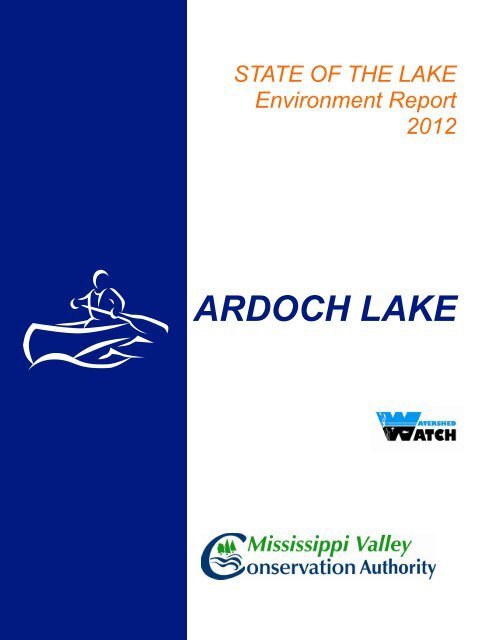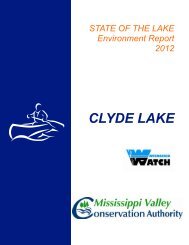ARDOCH LAKE - Mississippi Valley Conservation
ARDOCH LAKE - Mississippi Valley Conservation
ARDOCH LAKE - Mississippi Valley Conservation
Create successful ePaper yourself
Turn your PDF publications into a flip-book with our unique Google optimized e-Paper software.
STATE OF THE <strong>LAKE</strong>Environment Report2012<strong>ARDOCH</strong> <strong>LAKE</strong>
<strong>ARDOCH</strong> <strong>LAKE</strong>WHY WATERSHED WATCH?A lake monitoring program of the <strong>Mississippi</strong> <strong>Valley</strong> <strong>Conservation</strong> Authority<strong>Mississippi</strong> <strong>Valley</strong> <strong>Conservation</strong> Authority (MVCA) haslong recognized the recreational and aesthetic value oflakes within the watershed and is committed topreserving and protecting water quality and fish habitat.Since the launch of the Watershed Watch program in1998, MVCA has joined together with volunteer lakestewards throughout the watershed to take steps inrestoring and protecting water quality.Watershed Watch is an environmental monitoring andawareness program. The objectives of the program areto collect reliable environmental data to documentcurrent water quality conditions. This data is used as anessential educational tool to encourage residents toadopt sound stewardship practices aimed atmaintaining water quality. We will assist shoreline residents, both seasonal andpermanent, to become personal stewards of their lake by encouraging them to take onan active role in restoring and enhancing their shorelines. In this way, we will worktogether to maintain healthy lake environments throughout the watershed.ABOUT <strong>ARDOCH</strong> <strong>LAKE</strong>Located in the Township of NorthFrontenac.Elevation of 282 metres above sea level.Lake perimeter is 5.5 kilometresDeepest point is 17.4 metres.Warm water fishery, particularly:Walleye, Northern Pike, and SmallmouthBass.As of 2004 there were 10 cottages and 6campsites on the lake.2
12—21This map is intended for illustration only.It should not be used as a navigation guide.STATE OF THE <strong>LAKE</strong> REPORT 2012
HOW DOES <strong>ARDOCH</strong> <strong>LAKE</strong> MEASURE UP?WATER QUALITY RESULTS (1976 - 2012) - <strong>ARDOCH</strong> <strong>LAKE</strong> - MAIN BASIN** Includes Recreational Lakes Program Data.<strong>ARDOCH</strong> <strong>LAKE</strong>4
MVCA Monitoring Staff use 4 different sampling procedures to measure water quality.WATER CLARITYA Secchi Disc is a black and white coloured discused to determine water clarity. The disc islowered into the water. The point at which you canno longer distinguish the black and white is calledthe Secchi depth. The higher the Secchi Discmeasurement, the more clear your lake.Lakes are classified as oligotrophic, mesotrophic,or eutrophic, depending on age and whether theyhave little, some, or a lot of life, respectively.Oligotrophic lakes are the youngest, mesotrophiclakes are middle-aged lakes that are less deep andmore fertile than oligotrophic lakes, and eutrophiclakes (the oldest lakes) are most fertile and evenmore shallow than mesotrophic lakes.<strong>ARDOCH</strong> <strong>LAKE</strong> — MAIN BASINANNUAL MEAN SECCHI DISC DEPTHS (metres)STATE OF THE <strong>LAKE</strong> REPORT 2012
<strong>ARDOCH</strong> <strong>LAKE</strong>PHOSPHORUS LEVELSPhosphorus is the nutrient that controls thegrowth of algae in most Ontario lakes. For thisreason any increase in phosphorus in the lakewill increase the quantity of algae that cangrow. High levels of phosphorus can lead toalgal blooms and in some cases affect thehabitat of cold water fish such as lake trout. Ageneral guideline exists to characterize yourlake based on the total phosphorus that ismeasured.A Kremmerer Bottle (pictured to the right) isused to sample water at specific depths. Thebottle is lowered to the required depth withboth ends open. A weight on the rope isdropped. When the weight hits the bottle itcauses both ends to close, sealing the samplewater in the bottle.<strong>ARDOCH</strong> <strong>LAKE</strong> - MAIN BASINANNUAL MEAN TOTAL PHOSPHORUS RESULTS (ug/L)6
CHLOROPHYLL aWater clarity is influenced bythe amount of phytoplankton ormicroscopic algae present in thewater. Chlorophyll a is thegreen pigment inphytoplankton.The lower the chlorophyll adensity in your lake, the cleareryour lake is. Chlorophyll a isdirectly affected by the amountof total phosphorus in your lake.The more phosphorus there isin the water, the more algalgrowth will occur.A Composite Sampler (pictured above) is used by dropping the tin container into the water.When it reaches the required depth it is slowly pulled back to the surface. The tin is filled aswater enters one tube and air escapes the other. Some air remains in the tin to ensurecollection throughout the haul to the surface.<strong>ARDOCH</strong> <strong>LAKE</strong> - MAIN BASINANNUAL MEAN CHLOROPHYLL a RESULTS (ug/L)STATE OF THE <strong>LAKE</strong> REPORT 2012
<strong>ARDOCH</strong> <strong>LAKE</strong>pH LEVELS<strong>ARDOCH</strong> <strong>LAKE</strong> - MAIN BASIN2012 pH LEVELSHelp MVCA and theOntario Federation of Anglers and HuntersStop the Invasion!Ardoch Lake was tested for invasive species, particularly zebramussels, spiny water flea, and rusty crayfish, in partnership with theOntario Federation of Anglers and Hunters (OFAH). In 2012, zebramussel veligers (larvae), spiny water flea and rusty crayfish werenot present in the samples collected.Residents and property owners need to ensure that all access pointsto the lake have posted signs indicating the precautions thatboaters and anglers can take to prevent the spread of invasivespecies into Ardoch Lake. Residents are also invited to participate inthe Invading Species Awareness Program(www.invadingspecies.com) through MVCA and OFAH.The plankton haul net (pictured above) looks like a wind sock with a plastic cup attached to the end. The mesh size of thenet is 63 microns, which can filter microscopic organisms (plankton) like spiny water flea and zebra mussel veligers fromthe water. The plastic cup portion of the net is called the cod end. It collects the plankton sample as water passes throughthe net.Check and clean watercraftevery time it is moved to adifferent water body!Baited minnow traps (pictured right) with slightly widenedopenings on each end are used to sample for rusty crayfish.Traps are placed in shallow areas along the shoreline. Traps areleft for a minimum of 24 hours. If crayfish are found in thesample, MVC staff identify the species and release native crayfishback into the lake.8
For more information on these andother invasive species, visitwww.invadingspecies.com/invaders orcall the Invading Species Hotline at1-800-563-7711.If you would like to help monitor andprevent the spread of invasive speciesin the <strong>Mississippi</strong> <strong>Valley</strong> watershed,email monitoring@mvc.on.ca or call usat 613-253-0006.Top: Spiny water flea. Photo: Cathy DarnellLeft: Rusty Crayfish. Photo: Doug Watkinson, DFORight: Zebra mussels. Photo: Amy J. Benson, USGeological Survey.<strong>ARDOCH</strong> <strong>LAKE</strong> SAMPLING RESULTS—MAIN BASINDissolved Oxygen (DO) is adissolved form of oxygen vital for allunderwater plants and animals tosurvive; it's what they need to breath.Adequate dissolved oxygen isimportant for good water quality andnecessary to all forms of life. Poor(low) DO levels will cause stress onfish and may result in fish kills (massdeath of a species in a season).MVCA takes three DO readings eachsample season. By monitoring the DOlevels of our lakes we can developlake profiles showing the lakestratification and the state of the lake.Lake Stratification is the separationof lakes into three layers:The Dissolved Oxygen Metre is used to gather DOand temperature readings. The probe is loweredinto the lake and readings are taken at every metrefrom the hand-held screen.STATE OF THE <strong>LAKE</strong> REPORT 2012
<strong>ARDOCH</strong> <strong>LAKE</strong><strong>ARDOCH</strong> <strong>LAKE</strong> SAMPLING RESULTS—MAIN BASIN continued<strong>ARDOCH</strong> <strong>LAKE</strong> - MAIN BASIN #12-21MAY 24/2012 — 11:45AMWarm Water Fisheries Habitat (Bass, Walleye, Pike, Perch) defined as Dissolved OxygenConcentrations greater than 4 mg/L at temperatures less than 25°C.10
<strong>ARDOCH</strong> <strong>LAKE</strong> SAMPLING RESULTS—MAIN BASIN continued<strong>ARDOCH</strong> <strong>LAKE</strong> - MAIN BASIN #12-21JULY 12/2012 — 10:30AMWarm Water Fisheries Habitat (Bass, Walleye, Pike, Perch) defined as Dissolved Oxygen Concentrationsgreater than 4 mg/L at temperatures less than 25°C.STATE OF THE <strong>LAKE</strong> REPORT 2012
<strong>ARDOCH</strong> <strong>LAKE</strong><strong>ARDOCH</strong> <strong>LAKE</strong> SAMPLING RESULTS—MAIN BASIN continued<strong>ARDOCH</strong> <strong>LAKE</strong> - MAIN BASIN #12-21SEPTEMBER 4/2012 — 10:30AMWarm Water Fisheries Habitat (Bass, Walleye, Pike, Perch) defined as Dissolved OxygenConcentrations greater than 4 mg/L at temperatures less than 25°C.12
SEINE NETTINGSeine netting by hand is a way ofsampling fish species that may liveor visit the near shore areas of awaterbody. A seine net is a type offishing net that has floats along oneedge and weights along the otheredge, to keep it upright in thewater. It is then dragged through asection of water, encircling it, thuscollecting all the fish within thatarea. The depth of the testing areais limited to areas wadeable by thefield crew. This method has a verylimited impact on the health of thefish sampled and is affordable, easyto do, and portable.Seine netting was conducted at the boat launch sites of all the Watershed Watch lakes ofthe 2012 field season to help expand our knowledge of each lake beyond just itschemistry. Netting was conducted in August to avoid disturbing sensitive nesting andbreeding sites.The majority of the individual fish captured with the seine net are bait fish such asminnows and cyprinids, however some juvenile and adult game fish were also caught.Both groups (bait fish and juvenile game fish) tend to stick close to shore to avoidpredation from larger fish that can be found in deeper waters. Near shore areas may alsocontain aquatic vegetation which is ideal camouflage for all sizes of fish that are eitherhiding from predators, or waiting to surprise prey, explaining why some adult game fishwere caught.It is important to note that if something was not caught in the seine we cannot concludethat the fish species is not in the lake, rather that the species was not in the samplingzone when the sampling was done.Most stakeholder interest in fish species within a water body has to do with game fish.However, baitfish far outnumber game fish and thus play a critical role within theirecosystem and the food chain. It is important to take note of their presence, and providethem the same consideration you would for larger fish. If you are interested in learningmore about baitfish, and how to identify the different species, please refer to theDepartment of Fisheries and Oceans Baitfish Primer. It is available online and at the MVCoffice.<strong>ARDOCH</strong> <strong>LAKE</strong> SEINE NETTING RESULTS - FISH SPECIES CAUGHTSmallmouth bassSTATE OF THE <strong>LAKE</strong> REPORT 2012
MVCA would like to thank themany dedicated volunteersand the Lake Steward Networkfor their assistance with andsupport of the WatershedWatch program.For more information aboutMVCA Monitoring Programsplease call: 613.253.0006 ext. 235 oremail: monitoring@mvc.on.caorvisit: www.mvc.on.ca<strong>Mississippi</strong> <strong>Valley</strong> <strong>Conservation</strong> Centre10970 Hwy 7Carleton Place, OntarioK7C 3P1




